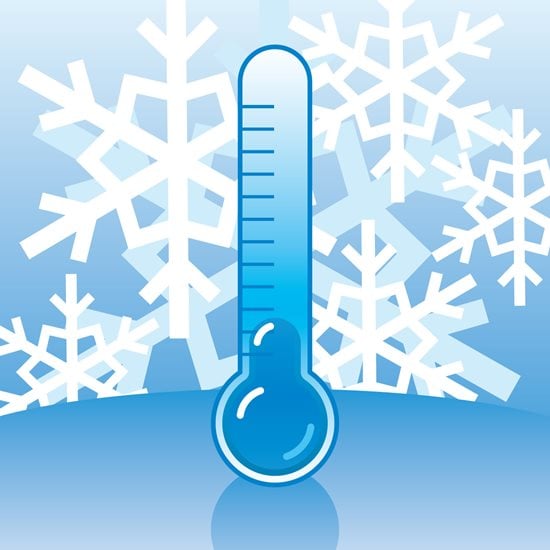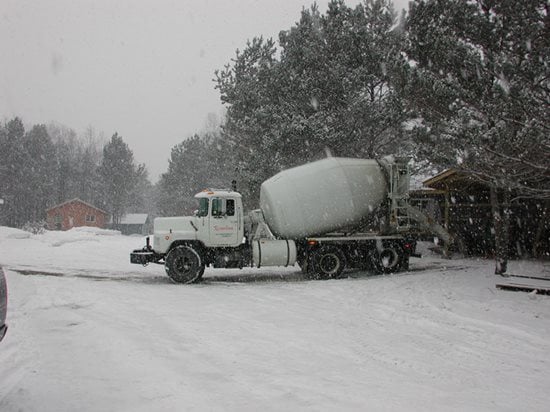- Cold Weather Concrete Home
- Why is Cold Weather a Problem?
- Dos and Don'ts When Placing Concrete in Cold Weather
- Cold Weather Curing Methods
- Can You Pour Concrete in the Rain?
- Related Information:
- Sealing Concrete in Cold Weather: Advice from technical expert Chris Sullivan
- Admixtures for Cold-Weather Concreting
- How to Melt Ice on Concrete Without Causing Damage
- Winterizing Concrete Driveways, Patios & More
- Hot Weather Concreting
Section Sponsor

Packaged Admixtures
Seasonal Pouring Tips
Get guidelines for placing concrete by region and season throughout the U.S.
SELECT A REGION
Why is Cold Weather a Problem When Pouring Concrete?
Find out what happens to concrete if it freezes and how to get the perfect cold weather concrete mixThere are two main problems with pouring concrete in cold winter weather:
- Concrete can freeze before it gains strength which breaks up the matrix
Concrete sets more slowly when it is cold—very slow below 50°F; below 40°F the hydration reaction basically stops and the concrete doesn't gain strength
But these are concrete temperatures not air temperatures. So when it's cold, we need to protect the concrete until it can handle the cold on its own. The general rule is that once the concrete has gained strength to about 500 psi then it's OK.
The magical thing that happens is that at almost the same time that the concrete achieves 500 psi compressive strength, hydration of the cement has consumed enough of the water in the original mix so that even if it does freeze, there's not enough water left in the pores to damage the concrete. With most concrete, even at 50°, this happens during the second day.
To help it reach that 500 psi strength, then, there are two things we can do in cold weather: Change the mix to get it to set more quickly or protect the concrete from the cold—or more likely, both.
Related: What is PSI?
Changes to Concrete Mix During Cold Weather
Many of the problems with cold weather can be overcome by the ready mix producer. Here are a few things to keep in mind:
-
Hot water—Your ready mixed concrete producer will usually have, and use, hot water in the concrete when the weather turns cold. Most producers will try to have the concrete be at least 65°F when it leaves the plant, which is generally good enough depending on air temperature and thickness of the concrete element.
-
Specify the slump at less than 4 inches and use air entrained concrete to reduce bleeding.
-
Accelerators—Since colder weather leads to colder concrete, the set time can be delayed. Accelerators added to the concrete can keep it on schedule. Addition of 2% (by weight of cement) of calcium chloride is the traditional way to accelerate the hydration reaction—it is very effective and reasonably cheap. But—a big but—that much chloride can lead to corrosion of any steel embedded in the concrete (like rebar) and it can lead to a mottled surface appearance with colored concrete (see Concrete Discoloration).
-
Nonchloride accelerators are widely available and are very effective. They won't discolor the concrete but they are a bit expensive. Don't make the mistake of thinking that accelerators are anti-freeze agents—they are not, they simply increase the rate of the hydration reaction.
-
Fly ash—You should typically stay away from using fly ash or slag cement in cold weather, since those materials set up more slowly and generate less internal heat; slag can cause the same effect.
-
To make the reaction a bit hotter, the ready mix producer can add some extra cement (typically an extra 100 pounds per cubic yard) or can use Type III (high-early strength) cement, which hydrates more rapidly.
-
Be careful with water reducers in cold weather, since they can slow the set time. Besides, you seldom need water reduction with cooler concrete since the cooler temperatures prevent slump loss.
For admixtures added at the job site, don't use them if they have frozen. The chemicals may have separated.












